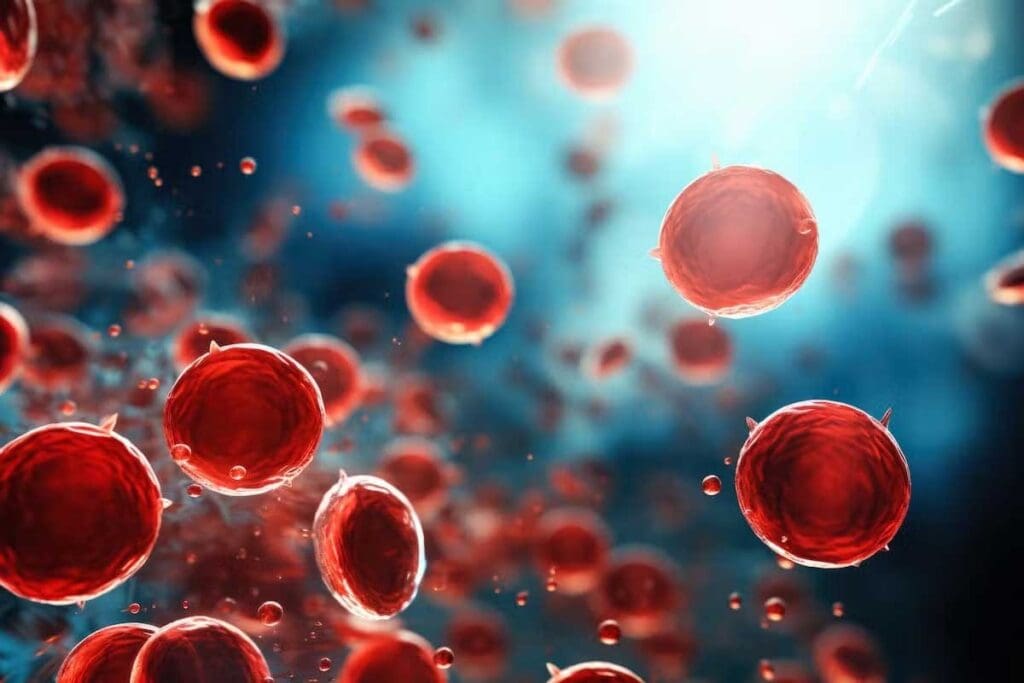Last Updated on November 20, 2025 by Ugurkan Demir

Learn about low red blood cells white blood cells and platelets. Get 7 serious causes and symptoms of this crucial blood issue.Feeling tired all the time, getting sick easily, and noticing bruises without any reason can be scary. These signs might mean your body has too few red and white blood cells and platelets. This is called pancytopenia, often caused by problems with bone marrow. At Liv Hospital, we’re here to help you with these tough health issues. We offer top-notch care and support for patients from around the world.
Pancytopenia is when you have too few of all blood cell types. We’ll look into what causes and shows this condition. We want to help you understand and deal with it.

To grasp blood disorders, knowing about red, white, and platelet cells is key. These cells work together to keep us healthy.
Red blood cells carry oxygen from the lungs to our body’s tissues. They have hemoglobin, a protein that holds oxygen. Without enough red blood cells or hemoglobin, we might feel tired, weak, and breathe short.
White blood cells are vital for our immune system. They fight infections by attacking harmful substances. There are different types, each with its own job. If we have too few white blood cells, we’re more likely to get sick.
Platelets help our blood to clot when we get hurt. They form a plug to stop bleeding. If we don’t have enough platelets, we might bruise easily or have bleeding gums.
Knowing the normal blood cell counts is important for health checks. These numbers can change slightly between labs. But here are the usual ranges:
Counts outside these ranges can signal health problems, like anemia or infections.

Pancytopenia is when the bone marrow can’t make enough blood cells. This leads to low counts of red blood cells, white blood cells, and platelets. It can happen for many reasons, like bone marrow failure or severe nutritional deficiencies.
Pancytopenia means there are fewer red blood cells, white blood cells, and platelets in the blood. This can cause anemia, more infections, and bleeding problems. It’s a serious condition that needs quick medical care.
Doctors say pancytopenia is a serious issue that needs immediate medical help. Knowing about it helps in early diagnosis and treatment.
Blood cells are made in the bone marrow through hematopoiesis. This process turns stem cells into red blood cells, white blood cells, and platelets. The bone marrow makes these cells, which then go into the bloodstream.
In pancytopenia, the bone marrow can’t make enough cells. This is because of bone marrow failure, cancer, or severe nutritional deficiencies.
Low blood counts are a concern if you have symptoms like fatigue, shortness of breath, or bleeding. If you’re feeling these symptoms, you should see a doctor.
Low hemoglobin and white blood cell count can mean there’s a problem that needs fixing. Anemia can also lower the white blood cell count. This shows why a full diagnosis is key.
“Early diagnosis and treatment of pancytopenia can significantly improve outcomes for patients.”
Medical Expert
Knowing the symptoms of low red blood cells, white blood cells, and platelets is key to managing pancytopenia well. When these counts are low, it can cause many health problems that need quick action.
Low red blood cells, or anemia, often cause fatigue. This is because red blood cells carry oxygen. With fewer red blood cells, tissues don’t get enough oxygen, leading to tiredness and weakness. Also, low hemoglobin can make breathing harder, as the body tries to get more oxygen.
Key symptoms to watch for include:
A low white blood cell count makes infections more likely. White blood cells fight off germs and invaders. With fewer white blood cells, the body can’t defend itself well, making infections more serious.
Low platelet counts can cause bleeding and bruising. Platelets help blood clot. Without enough platelets, even small injuries can bleed a lot, and bruises appear easily.
| Symptom | Description |
| Bleeding gums | Bleeding while brushing teeth or spontaneously |
| Easy bruising | Bruises appearing without significant trauma |
| Nosebleeds | Frequent or prolonged nosebleeds |
It’s important to know when symptoms are emergencies. Severe fatigue, trouble breathing, signs of infection, or a lot of bleeding need quick medical help.
We stress the need to be aware of these symptoms and get medical help when needed. Early treatment can greatly improve outcomes for those with pancytopenia.
Aplastic anemia is a main reason for low blood counts. It’s a serious condition where the bone marrow can’t make enough blood cells. This includes red blood cells, white blood cells, and platelets.
Bone marrow failure in aplastic anemia can happen for many reasons. These include toxins, some medicines, viral infections, and autoimmune disorders. Sometimes, we don’t know the exact cause. It’s important to understand these reasons to find the right treatment.
Aplastic anemia can be either acquired or inherited. Acquired aplastic anemia is more common. It can be caused by chemicals, radiation, or certain drugs. Inherited aplastic anemia is linked to genetic mutations and can be part of inherited syndromes.
Diagnosing aplastic anemia involves several steps. Blood tests check the levels of different blood cells. A bone marrow biopsy looks at the marrow’s cellularity. Genetic testing finds any underlying genetic causes. Early diagnosis is key to starting the right treatment.
Treatment for aplastic anemia depends on the severity and cause. It can include blood transfusions, immunosuppressive therapy, and bone marrow transplantation. The outcome varies based on treatment response and any underlying conditions. Timely and proper treatment can greatly improve outcomes for patients with aplastic anemia and related conditions like low white blood count anemia.
Blood cancers like leukemia, lymphoma, and multiple myeloma can harm the bone marrow. This harm stops the normal making of blood cells. As a result, red blood cells, white blood cells, and platelets are made in lower numbers.
Leukemia is a blood cancer that starts in the bone marrow. It makes too many bad white blood cells. These cells take over, stopping the bone marrow from making healthy cells.
People with leukemia often have anemia with low WBC and platelets. This makes them more likely to get sick and bleed easily.
Lymphoma is another blood cancer that can hit the bone marrow. When it does, it lowers the production of healthy blood cells. This can lead to low hemoglobin and platelets.
Patients may feel tired, get sick easily, and have trouble with bleeding.
Multiple myeloma is a cancer of plasma cells that messes with the bone marrow. It grows bad plasma cells, which stop normal blood cells from being made. This causes anemia, low white blood cells, and low platelets.
Treating pancytopenia from blood cancers means fighting the cancer itself. This might include chemo, targeted therapy, radiation, or a bone marrow transplant. The aim is to get rid of the cancer and help the bone marrow make healthy blood cells again.
Supportive care, like blood transfusions and growth factor therapy, helps manage symptoms and complications of pancytopenia.
Nutritional deficiencies can harm our blood cell counts, causing pancytopenia. Eating a balanced diet is key to making red blood cells, white blood cells, and platelets. Without the right nutrients, our body can’t make these cells well, leading to health problems.
Vitamin B12 and folate are vital for making red blood cells. Not having enough of these vitamins can cause megaloblastic anemia. This condition makes red blood cells big and abnormal, and can also lower white blood cells and platelets.
Key effects of Vitamin B12 and Folate deficiency:
Iron is key to making hemoglobin, a protein in red blood cells. Iron deficiency can cause anemia, with low hemoglobin levels. While it mainly affects red blood cells, severe cases can also harm white blood cells and platelets.
Iron deficiency can lead to:
Copper is vital for making red blood cells and keeping connective tissues healthy. A copper deficiency can cause anemia and affect other blood cells. Trace elements like zinc and selenium are also important for immune function and health.
Effects of copper deficiency include:
Certain medicines and treatments can cause pancytopenia. This is a condition where you have low counts of red blood cells, white blood cells, and platelets. It can lead to low wbWBCnd anemia and other problems.
This happens because these treatments can slow down the bone marrow. The bone marrow is where these cells are made. Knowing the risks of different treatments is key to managing and preventing pancytopenia.
Chemotherapy and radiation therapy can harm the bone marrow. They target fast-growing cells, like cancer cells, but also affect the bone marrow. This can lead to low WBC and anemia.
People getting these treatments need to have their blood counts checked often. This helps manage the risk of pancytopenia.
Some antibiotics and antimicrobials can also affect blood cell production. For example, some antibiotics can slow down the bone marrow. This can reduce the counts of red blood cells, white blood cells, and platelets.
Some medications for seizures and mental health issues can cause pancytopenia. It’s important to watch blood counts for patients on these drugs. This helps prevent serious problems like severe anemia and low WBC counts.
To manage drug-induced pancytopenia, it’s important to keep an eye on blood counts. Treatment plans may need to be changed. Sometimes, doctors might choose different medications or therapies to lower the risk. This is important for patients already dealing with low WBC and anemia.
| Medication/Treatment | Effect on Blood Cells | Monitoring Recommendations |
| Chemotherapy | Suppresses production of RBC, WBC, and platelets | Regular CBCs |
| Certain Antibiotics | Can cause bone marrow suppression | Monitor CBCs, especially during long treatments |
| Anti-Seizure Medications | May affect WBC and platelet counts | Regular monitoring of CBCs |
| Psychiatric Medications | Can impact WBC counts | Periodic CBC checks |
Autoimmune diseases and infections can mess with how our bone marrow makes blood cells. This is key to understanding pancytopenia. These conditions can really hurt the bone marrow’s job.
Systemic Lupus Erythematosus (SLE) and Rheumatoid Arthritis (RA) can cause pancytopenia. SLE makes the immune system attack healthy tissues, including the bone marrow. This can lower blood cell counts. RA causes inflammation that can harm the bone marrow, too.
These conditions have a few main features:
Viral infections can mess with blood cell production. HIV attacks and kills CD4+ T lymphocytes, leading to low blood cell counts. Hepatitis viruses can harm the liver, affecting blood cell production. Cytomegalovirus (CMV) directly infects bone marrow cells, slowing down blood cell production.
Here are some key effects of viral infections:
Bacterial infections can cause sepsis, a serious condition that can lead to pancytopenia. Sepsis can damage the bone marrow by releasing inflammatory cytokines. Conditions like septicemia can directly lower blood cell counts.
Treating immune-mediated pancytopenia means tackling the root cause. For autoimmune diseases, drugs that suppress the immune system may be needed. For infections, antibiotics are key. Supportive care, like blood transfusions and growth factors, helps manage symptoms and prevent worse problems.
Here are some treatment options:
It’s key to know the causes and signs of low red blood cells, white blood cells, and platelets. Pancytopenia is a complex issue that needs a detailed approach to find and treat it.
Diagnosing pancytopenia means checking blood cell counts and bone marrow function. At Liv Hospital, we aim to give top-notch care to those with pancytopenia and other complex health issues. Early diagnosis and treatment are essential to manage low blood cells and platelets well.
We stress the need to recognize symptoms and get medical help when needed. Our team is committed to giving full support to international patients. We make sure they get the best care for their condition.
Pancytopenia is when the bone marrow doesn’t make enough blood cells. This leads to low counts of red blood cells, white blood cells, and platelets.
Symptoms vary based on the blood cell type affected. Fatigue and shortness of breath come from low hemoglobin. Low white blood cells increase infection risk. Low platelets cause bleeding and bruising.
Pancytopenia can be caused by several things. These include bone marrow failure, cancer cells in the marrow, severe nutritional deficiencies, certain medicines, and autoimmune diseases.
Diagnosing pancytopenia involves understanding its causes and recognizing symptoms. A detailed diagnostic approach is used, including blood tests and bone marrow exams.
Yes, not getting enough nutrients like vitamin B12, folate, and iron can harm blood cell production. This can lead to pancytopenia.
Blood cancers like leukemia, lymphoma, and multiple myeloma can fill the bone marrow. This disrupts normal blood cell production, causing pancytopenia.
Yes, some medicines, including chemotherapy, antibiotics, and psychiatric drugs, can lower blood cell counts. This can lead to pancytopenia.
Bone marrow makes blood cells, including red blood cells, white blood cells, and platelets. Any problem with the bone marrow can cause pancytopenia.
Treatment for pancytopenia depends on the cause and severity. It may include fixing nutritional deficiencies, managing underlying conditions, and adjusting medications.
You should seek medical help right away if symptoms are severe. This is to prevent serious problems like severe bleeding, infections, or anemia.
Anemia and low white blood cell count often happen together in pancytopenia. Both are due to the bone marrow’s failure to produce blood cells.
Anemia itself might not directly cause a low white blood count. But both can be signs of a problem with the bone marrow, like pancytopenia or failure.
Low hemoglobin causes fatigue and shortness of breath. Low platelets lead to bleeding and bruising. Both are reasons to see a doctor quickly.
Subscribe to our e-newsletter to stay informed about the latest innovations in the world of health and exclusive offers!